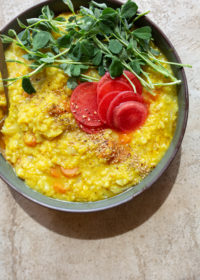Ayurveda: Rasa – The Six Tastes of Ayurveda | Bitter
This guest post from Adena Rose Ayurveda is part of a six part series on the essential tastes of Ayurveda – catch the other 5 tastes here!
“There are only two mantras: yum and yuck. Mine is yum.” This is one of my favorite quotes from one of my favorite novelists, Tom Robbins. It came to mind because today I’m expounding on the bitter taste – and very, very few things that taste bitter make us say ‘yum.’ In fact, bitter is designed more for yuck. And that’s part of the medicine of this flavor.
I last wrote in May about Katu, or Pungent taste, and how it affects our body and mind. Any substance may be used as medicine when we understand its qualities, and taste is one of those qualities that we can start to understand as soon as we put it to our tongue. Taste is a signifier of how the substance will affect our body. Whether it might heal or harm us – move us towards balance, or away from it. Ayurveda explains that there are six tastes: Sweet, Sour, Salty, Pungent, Bitter and Astringent. Some of these may seem obvious, and others more enigmatic. Each of the tastes is also comprised of the five elements, two which are the most dominant. This means that the tastes affect the doshas, Vata, Pitta and Kapha, which are also made of the 5 elements. You can use the chart below to see which tastes balance which doshas, and which elements each taste contains. After all, the doshas are nothing but the elements. And in Ayurvedic understanding, like increases like. If we want to lessen the effects of a dosha which is showing up as too high, we will eat foods with the tastes that have elements which are not the same as those in the dosha which is out of whack – those ‘subdue’ the dosha. Beyond the tastes, of course we want to ingest food full of prana, the life-force energy, and we also want to be sure we are chewing our food slowly, and digesting it fully. If you want to know more, I have made three short videos, each with a concrete tip for turning your diet into a healing diet. You can get those here.
TIKTA : BITTER
So, can we say yum to the yuck? Most foods, even foods we use medicinally have more than 1 flavor in their profile. Some of our favorite foods have a bitter taste to them – namely, chocolate and coffee. I maintain that anything can be medicine, neutral, or poison depending on when and how they are used. I am sure that you can think of a time when these items have been all 3 for you! Bitter is an important taste for medicines. This ‘yuck’ quality of bitter implies that it’s a very cleansing taste. Just like when we take a bitter herb or bite of something very bitter we naturally go to split it out, our body and cells wants to do the same thing. And when the cells or the digestive systems spits out what was ingested, other things go with it. This makes the bitter taste is a powerful detoxifying agent. If you put a bit of bitter herbal powder – a very important and well-known bitter Ayurvedic herb is neem – your mouth will start to water to wash that intense taste away. This is one of the properties of bitter taste. Bitter is consider astringent, and drying, because it pulls moisture from the tissues. It is lightening, as opposed to nourishing. The very bitter herbs are consider to have antibiotic, anti-parasitic, and antiseptic qualities. Bitter herbs can be used in different ways depending on the amount you use – in a large amount, a bitter herb can be a purgative, and in smaller amounts, it can actually improve agni and digestion in certain cases. Bitter herbs also have an affinity for cleansing the liver, purifying the blood – both dominated by Pitta dosha. The SAD (Standard American Diet) favors the sweet taste. Bitter is avoided, basically because we can. When we were living off of the land, we had to eat a lot of bitter, during certain seasons, because it might have been all we had, or perhaps also we understood it’s importance in our ability to digest heavier things, like cured meats or dairy. The most natural time of year to eat bitters is in the Spring, and Summer, when greens are plentiful. These are the seasons when Kapha and Pitta are dominant, respectively, and the bitter taste brings those 2 doshas into balance, but it is very aggravating to Vata. Bitter is made from the elements of Air and Space (Ether). If you remember the make-up of the doshas, you’ll note that Vata is also made of these elements. In excess, bitter foods create gas and constipation, common signs of a Vata-imbalance in the digestive system.
So which foods are bitter? And how to appropriately use them? Any greens, fresh or cooked, are considered bitter, and probably astringent. Some have pungency, as well, so you can see how there are varying degrees. If you tend towards constipation and gas, avoid salads. And if you love your greens (who doesn’t?) experiment with using digestive spices to help balance out the bitter qualities. This is true for everything we cook – we can learn to use spices to tailor our meals to our needs, to tailor seasonal ingredients to our constitution. Zucchini, eggplant, grapefruit and olives and olive oil are bitter, radicchio is a famous bitter leaf that I love grilled or broiled with some good olive oil. And in India and Asian cuisine, bitter melon or bitter gourd is more common. Green tea also has some bitterness to it. If you want to experiment with adding a bit of bitter taste to your food, spices are a great way to go. Try more turmeric, fenugreek, basil and – even fresh ginger includes bitter in its flavor profile.
Common medicinal bitter herbs from the Ayurvedic and western tradition include aloe vera, dandelion, goldenseal, neem, kutki, and nettle. Bitter ghee, or tikta ghrta, is another way to use bitter herbs, cloaked in the nourishing and oily qualities of ghee. Tikta ghrta is used often during cleansing, or in small amounts to improve digestion but reduce Pitta when an extreme cleansing regime is not appropriate.
The bitter taste should be a small percentage of your meal, smaller if you have a lot of Vata in your constitution, and perhaps a bit more if you have Pitta or Kapha dominant. A bit of bitter tea before your meal (or squirt of bitter tincture in warm water), a pinch of fenugreek in your saute, or a slice of fresh ginger before eating is a great way to improve your digestion, and get your bitters in. Think again about what your eating, and why. Even a diet full of raw greens, a diet extremely cleansing, is not sustainable for long periods. It would put you in a state of constant cleanse, without much nourishment. It’s all about balance, and pays to understand the seasonal influences, as well as your constitution. It can start to feel overwhelming, all of this ‘awareness.’ It’s important to experiment, to try it out and see what works for you. Once we are aware of how the choices we make affect how we feel, then we can get out of our heads, and all of that information can transform into wisdom and intuition. And we can relax more, trusting our choices will serve us well. What’s your favorite way to get your bitters in? I am grateful for dandelion root tea!
————


Adena Harford is an Ayurvedic Practitioner and creator of Adena Rose Ayurveda. If you’re interested to experience using food as medicine, apply for The Healing Diet 10 week program.
 [wpmenucart]
[wpmenucart]



I really like and appreciate your blog post. Much obliged.
Great, thanks for sharing this article.Much thanks again.
Very interesting. Even as I eat what I know tastes good (but also poison), I also can eat something other people say yuck about, easily feeling it is earthy tasting and good for me. This is a great reminder to check in with myself and what resonates. I know I’ve been out of balance but when I try, my instincts never lie. I just don’t check in and listen.